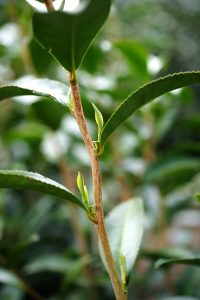
Soufuu (蒼風, そうふう) is a Japanese tea cultivar with a pleasant floral aroma. It loosely translates as “green wind”.
It is intended for both sencha and oolong production, but it also gives good results as kamairicha.
While not one of the better known cultivars, it has been getting much attention in recent years.
History of the Soufuu cultivar
In 1977, Shizuoka prefecture, a Yabukita plant was crossed with another cultivar named Shizu inzatsu 131 (静印雑131).
Shizu inzatsu 131 belongs to the Assamica variety and has an Indian origin. The best seedling was selected out of these hybrids and named Soufuu.
Finally, it was registered in 2002 as Japanese tea cultivar #49.
Characteristics of Soufuu
What’s most interesting about this cultivar is that it has a jasmine-like aroma that had never been present in Japanese tea cultivars until then.
Research showed that this is due to its anthranilic acid content, which is also found as an aroma component in jasmine.
This early-budding cultivar can be harvested up to a week earlier than Yabukita and has a similar yield.
Although Soufuu is resistant against some diseases, it is weak against the blister blight and the bacterial shoot blight, so care must be taken in places where these diseases are prevalent.
It also a little less tolerant to cold weather than Yabukita, so it’s best suited to warm regions.
Soufuu releases less aroma with a longer steaming process, hence it doesn’t do that well as a fukamushicha.

January 13, 2015
Very interesting info Riccardo. Thank you for sharing it. My interest has been peaked. Hope you are well. 🙂
January 13, 2015
Thanks for reading Rachel.
Besides Yabukita, it’s very difficult to get Japanese teas from other cultivars. So I’m mostly doing this for academic purposes 🙂
January 14, 2015
I love these cultivar articles of yours. Can’t say I recall running into Soufuu before, at least not to my knowledge. And I’ve only run into Kamairicha once.
January 14, 2015
Hi Geoff
Thanks for your kind comment.
I haven’t tried this cultivar myself either, what I do is to find all the info that I can from Japanese sources and then summarize it into an article.
I have a kamairicha from Ureshino. The review is pending, along with many other teas.
January 18, 2015
Hola!
It is always nice to read posts about various cultivars in your blog. For someone like me who is interested in Japanese cultivars, it is a source of concise reference material.
Thank you.
January 19, 2015
Hola lochan
As always, thank you for your interest in my cultivar posts.
November 23, 2019
Great! Sorry I already made a comment on this but I think that was way back. So I must have forgotten that you had already done something on Sofu. My apology. In my travels to Japan in the recent few years 3 cultivars have picked up attention a lot – Sofu, Koshun and Izumi.
By the way there is a Japanese book with different cultivars that was published about 16 years ago. Do you know if there has been an update or an English version?
Do contact me by mail and we can discuss more!
November 23, 2019
Hi Lochan, I have a cultivar book from 2019, that’s the newest that I have. I’ll send you an email.